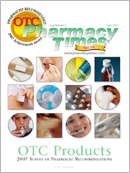Publication
Article
OTC Guide
Behind-the-Counter Meds: Time for a Third Category?
Author(s):
The controversies surrounding the emergency contraception pill Plan B (levo-norgestrel) and the decongestant pseu-doephedrine (PSE), as well as the recent news about dextromethorphan (DM), have sent these medications into the pharmaceutical limbo known as behind the counter (BTC). In a middle ground between OTC and prescription-only medicines, these products are accessed by patients only after discussion with the pharmacist and presenting proof of identification (ID). The reasoning behind putting certain drugs behind the pharmacy counter was to limit their use by those who might misuse them, while still maintaining reasonable access for legitimate patients without making them get a prescription.
Pseudoephedrine
A popular and effective decongestant, PSE has been recommended by physicians and pharmacists for many years. When the Drug Enforcement Administration found that it was being used to make illegal methamphetamine, however, PSE was moved behind pharmacy counters to discourage bulk sales and shoplifting of the drug. Now, patients seeking congestion relief from PSE must sign logbooks in addition to presenting IDs to get the medication. Although some pharmacists hoped that this would encourage more dialogue between patients and pharmacists about medications, they are finding the inconvenience is putting some patients off PSE altogether.
A number of pharmacists suspect that some patients, perhaps unaware of the new regulation, have become confused by replacement drugs that substitute phenylephrine (PE) for PSE because they are packaged similarly to the original products. They claim this is one possible reason behind the drop in sales of such PSE regulars as Sudafed and its generic equivalents. Alan Rosenthal, RPh, of the Suburban Pharmacy in West Hartford, Conn, fears that patients are accidentally settling for cold products that are not as effective as those they can access from BTC. He admits being asked by patients about the efficacy of PE. “I tell them that PSE is a better product,” he said.
Plan B
In August 2006, the FDA agreed to approve Plan B as an OTC medicine for women aged 18 and older. To enforce the regulation, however, pharmacists have to keep the product BTC; patients seeking the drug must first provide proof of age. Some argue that this is not true OTC status because it does not allow access to medications outside of pharmacist intervention.
Barr Pharmaceuticals, which makes Plan B, began shipping the OTC version to pharmacies in mid-November of last year. Most major pharmacies, such as Wal-Mart, are using the “conscientious-objection” policy, which allows a pharmacist who objects to selling Plan B on moral or religious grounds to step away from the transaction and allow a coworker to complete it. Most other major chains will also carry the drug, but surprisingly, some independents are debating whether to supply the drug at all due to lack of previous demand. Ike Vlahos, owner of Jones-town Pharmacy in Winston-Salem, NC, said in the past 2 years he has had only 4 prescriptions come in for Plan B and probably will not carry the OTC version. “I don’t know how the public will feel about stepping up to the counter and asking for it,” he said.
Dextromethorphan
A key ingredient in many OTC cough medicines, DM is an effective antitussive when taken in the proper doses. Recent studies have found, however, that American adolescents are ingesting DM-containing medicines in dangerous amounts to “get high.” The cheapness and availability of DM products (compared with street drugs) makes it more appealing to teens and disconcerting to health experts. Many major pharmacy chains have voluntarily pulled DM from their shelves and will sell only to customers aged 18 and older with proof of ID. The Consumer Healthcare Products Association and the National Association of Chain Drug Stores are looking at whether sales of DM products should be restricted to customers older than 18 in an effort to halt the spread of this growing trend.
An Official Third Class?
The FDA is reexamining whether it would be possible to create an intermediate or third class of drugs. Andrew von Eschenbach, MD, commissioner of the FDA, stated that a third class of drugs might expand access to certain medicines that are currently available only with a doctor’s prescription. The American Pharmacists Association and the American Society of Health-System Pharmacists both expressed support for the establishment of a third drug class. The FDA expects to begin working with key stakeholders soon to evaluate whether regulations currently in place would allow for the development of a BTC class, or whether new legislation is needed. To establish a new class of drug, Congress would have to issue an official act.
Several countries, including the United Kingdom (UK), Canada, and Australia, already have an official class for drugs available from BTC, referred to as “pharmacy (P),” “pharmacist only,” or “Schedule 3.” In the UK, half of the medicines available without a prescription fall into this category. Some pharmacy experts feel that installing a third drug class would provide a much-needed boost to pharmacists—not just in their budgets, but in their morale as well. They believe that pharmacists want to become more involved in their patients’ health care, and BTC medicines would encourage that interaction.
Conclusion
Although several medications have had to go BTC in the United States in recent years, the idea of installing an official third class has yet to catch on with the majority of Americans. As more branded drugs go off patent and face generic competition in the prescription-only market, however, there may be more insistence from pharmaceutical companies to reopen the idea of a federally mandated third class of medicines.
Ms. Bodine is assistant editor for Pharmacy Times.







